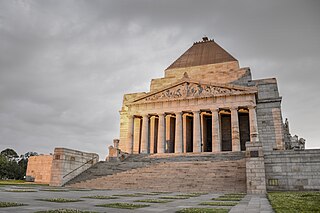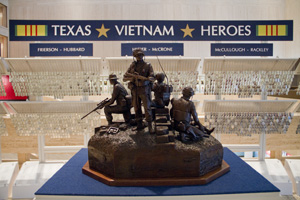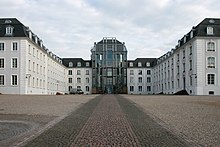
Maya Ying Lin is an American architect, designer and sculptor. Born in Athens, Ohio to Chinese immigrants, she attended Yale University to study architecture. In 1981, while still an undergraduate at Yale she achieved national recognition when she won a national design competition for the planned Vietnam Veterans Memorial in Washington, D.C. The memorial was designed in the minimalist architectural style, and it attracted controversy upon its release but went onto become influential. Lin has since designed numerous memorials, public and private buildings, landscapes, and sculptures. In 1989, she designed the Civil Rights Memorial in Montgomery, Alabama. She has an older brother, the poet Tan Lin.

The Vietnam Veterans Memorial, commonly called the Vietnam Memorial, is a U.S. national memorial in Washington, D.C., honoring service members of the U.S. armed forces who served in the Vietnam War. The two-acre (8,100 m2) site is dominated by two black granite walls engraved with the names of those service members who died or remain missing as a result of their service in Vietnam and South East Asia during the war. The Memorial Wall was designed by American architect Maya Lin and is an example of minimalist architecture. The Wall, completed in 1982, has since been supplemented with the statue Three Soldiers in 1984 and the Vietnam Women's Memorial in 1993.

John Gutzon de la Mothe Borglum was an American sculptor best known for his work on Mount Rushmore. He is also associated with various other public works of art across the U.S., including Stone Mountain in Georgia, statues of Union General Philip Sheridan in Washington D.C. and in Chicago, as well as a bust of Abraham Lincoln exhibited in the White House by Theodore Roosevelt and now held in the United States Capitol crypt in Washington, D.C.

Walter Seymour Allward was a Canadian monumental sculptor best known for the Canadian National Vimy Memorial. Featuring expressive classical figures within modern compositions, Allward's monuments evoke themes of memory, sacrifice, and redemption. He has been widely praised for his "original sense of spatial composition, his mastery of the classical form and his brilliant craftsmanship".

A monument is a type of structure that was explicitly created to commemorate a person or event, or which has become relevant to a social group as a part of their remembrance of historic times or cultural heritage, due to its artistic, historical, political, technical or architectural importance. Some of the first monuments were dolmens or menhirs, megalithic constructions built for religious or funerary purposes. Examples of monuments include statues, (war) memorials, historical buildings, archaeological sites, and cultural assets. If there is a public interest in its preservation, a monument can for example be listed as a UNESCO World Heritage Site. The Palgrave Encyclopedia of Cultural Heritage and Conflict gives the next definition of monument:
Monuments result from social practices of construction or conservation of material artifacts through which the ideology of their promoters is manifested. The concept of the modern monument emerged with the development of capital and the nation-state in the fifteenth century when the ruling classes began to build and conserve what were termed monuments. These practices proliferated significantly in the nineteenth century, creating the ideological frameworks for their conservation as a universal humanist duty. The twentieth century has marked a movement toward some monuments being conceived as cultural heritage in the form of remains to be preserved, and concerning commemorative monuments, there has been a shift toward the abstract counter monument. In both cases, their conflictive nature is explicit in the need for their conservation, given that a fundamental component of state action following the construction or declaration of monuments is litigating vandalism and iconoclasm. However, not all monuments represent the interests of nation-states and the ruling classes; their forms are also employed beyond Western borders and by social movements as part of subversive practices which use monuments as a means of expression, where forms previously exclusive to European elites are used by new social groups or for generating anti-monumental artifacts that directly challenge the state and the ruling classes. In conflicts, therefore, it is not so much the monument which is relevant but rather what happens to the communities that participate in its construction or destruction and their instigation of forms of social interaction.

Relief is a sculptural method in which the sculpted pieces remain attached to a solid background of the same material. The term relief is from the Latin verb relevare, to raise. To create a sculpture in relief is to give the impression that the sculpted material has been raised above the background plane. When a relief is carved into a flat surface of stone or wood, the field is actually lowered, leaving the unsculpted areas seeming higher. The approach requires a lot of chiselling away of the background, which takes a long time. On the other hand, a relief saves forming the rear of a subject, and is less fragile and more securely fixed than a sculpture in the round, especially one of a standing figure where the ankles are a potential weak point, particularly in stone. In other materials such as metal, clay, plaster stucco, ceramics or papier-mâché the form can be simply added to or raised up from the background. Monumental bronze reliefs are made by casting.

The Shrine of Remembrance is a war memorial in Melbourne, Victoria, Australia, located in Kings Domain on St Kilda Road. It was built to honour the men and women of Victoria who served in World War I, but now functions as a memorial to all Australians who have served in any war. It is a site of annual observances for Anzac Day and Remembrance Day, and is one of the largest war memorials in Australia.

Frederick Elliott Hart was an American sculptor. The creator of hundreds of public monuments, private commissions, portraits, and other works of art, Hart is most famous for Ex Nihilo, a part of his Creation Sculptures at Washington National Cathedral, and The Three Servicemen, at the Vietnam Veterans Memorial in Washington, D.C.
The National Capital Memorial Advisory Commission is an independent agency of the United States government responsible for approving and siting memorials within Washington, D.C., and the D.C. metropolitan area. Previously known as the National Capital Memorial Advisory Committee, the agency was established by the Commemorative Works Act of 1986 and its name was changed to the National Capital Memorial Commission. The agency's name was changed again in 2003 to the National Capital Memorial Advisory Commission.

The Hmong and Lao Memorial, or Lao Veterans of America Monument, is a granite monument, bronze plaque and living memorial in Arlington National Cemetery in the US. Dedicated in May 1997, it is located in Section 2 on Grant Avenue between the path to the JFK memorial and the Tomb of the Unknowns, in Arlington National Cemetery, Arlington, Virginia, in the United States. The Laos–Hmong memorial commemorates the veterans of the "Secret War" in Laos who fought against invading Soviet Union-backed North Vietnam Army forces of the People's Army of Vietnam and communist Pathet Lao guerrillas. Approved by the U.S. Department of Defense, Arlington National Cemetery, and the U.S. Department of the Army, but designed and paid for privately by the Lao Veterans of America, Inc., the Lao Veterans of America Institute, and The Centre for Public Policy Analysis, the memorial stands as a tribute to the Hmong, Lao, other ethnic groups, and American clandestine and military advisers who made up the Secret War effort during the Vietnam War. The Lao Veterans of America, Inc. is the nation's largest ethnic Laotian- and Hmong-American veterans organization.

The Judenplatz Holocaust Memorial also known as the Nameless Library stands in Judenplatz in the first district of Vienna. It is the central memorial for the Austrian victims of the Holocaust and was designed by British artist Rachel Whiteread.

Alexander "Sandy" Stoddart is a Scottish sculptor, who, since 2008, has been the Queen's Sculptor in Ordinary in Scotland and is now the King's Sculptor in Ordinary. He works primarily on figurative sculpture in clay within the neoclassical tradition. Stoddart is best known for his civic monuments, including 10-foot (3.0 m) bronze statues of David Hume and Adam Smith, philosophers during the Scottish Enlightenment, on the Royal Mile in Edinburgh, and others of James Clerk Maxwell, William Henry Playfair and John Witherspoon. Stoddart says of his own motivation, "My great ambition is to do sculpture for Scotland", primarily through large civic monuments to figures from the country's past.

The Texas Capitol Vietnam Veterans Monument, is a memorial designed by New Mexico artist Duke Sundt, installed on the grounds of the Texas State Capitol in Austin, Texas, United States. It serves as a tribute to all Texans who served in the Vietnam War and a memorial to the 3,417 who died. Ground was broken on March 25, 2013 on the northeast side of the Capitol. The monument was dedicated on March 29, 2014.

The Platz des Unsichtbaren Mahnmals – or in English, the Place of the Invisible Memorial – is a memorial to Jewish cemeteries. It is located in Saarbrücken, capital of the German state of the Saarland. To the visitor, the memorial is completely invisible – it only appears as a sign at the place, reading "Platz des Unsichtbaren Mahnmals".
The Theodore Roosevelt Memorial is a lost monument and sculpture commemorating the 26th president of the United States, Theodore Roosevelt, as well as veterans of the Spanish–American War. It was originally installed in Portland's Battleship Oregon Park. Designed by American artist Oliver L. Barrett, the 18-foot (5.5 m) memorial was erected in 1939, but disappeared in 1942 after being relocated temporarily during the construction of Harbor Drive. It featured a geometric tufa statue depicting a man not resembling Roosevelt, as well as a smaller realistic sculpture of him. The monument initially received a generally unfavorable reception, but was considered one of Barrett's best-known artworks.

The Clarke Memorial Fountain is a large public fountain on the campus of the University of Notre Dame in Notre Dame, Indiana, United States.

In Mexico, antimonumentostransl. anti-monument are installed and traditionally placed during popular protests. They are installed to recall a tragic event or to maintain the claim for justice to which governments have failed to provide a satisfactory response in the eyes of the complainant. Many of these are erected for issues related to forced disappearances, massacres, femicides and other forms of violence against women, or any other act of violence.
Mechtild Widrich is an Austrian art historian, curator, and Professor at the School of the Art Institute of Chicago.
Pritika Chowdhry is an Indian-born American artist, curator, and writer. She is known for her work in the socio-political domain.
Beyond Granite: Pulling Together is the title of a contemporary art exhibition held on the National Mall in Washington, D.C., from August to September 2023. Organized by the Trust for the National Mall, the National Capital Planning Commission, and the National Park Service, and curated by the nonprofit Monument Lab, Pulling Together was the first curated outdoor art exhibition in the Mall's history and the first in a planned series of outdoor exhibitions and installations under the Beyond Granite moniker.
















